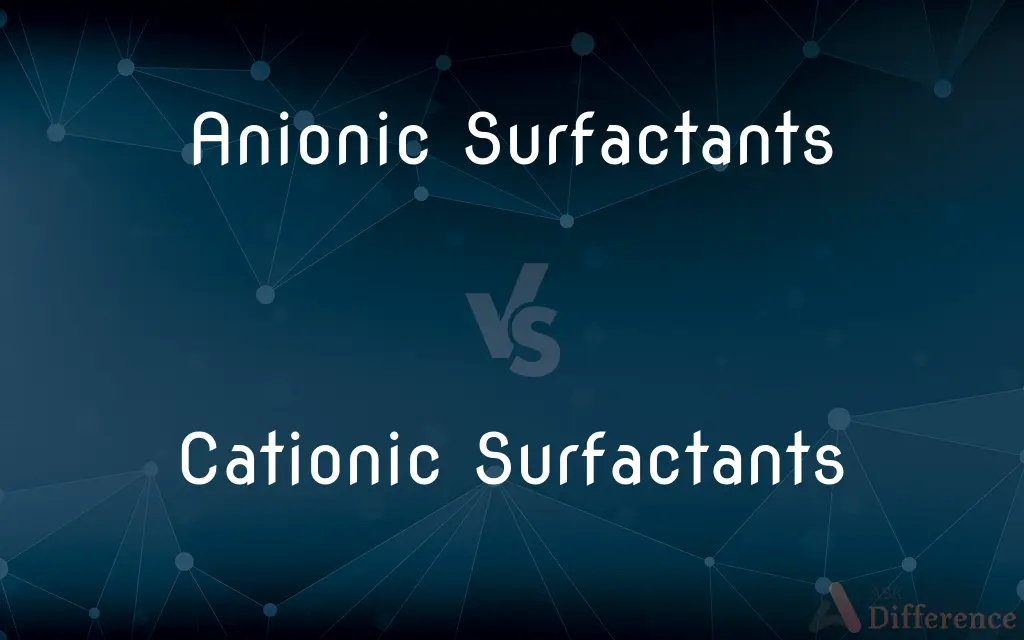Anionic Surfactants vs. Cationic Surfactants — What's the Difference?
By Maham Liaqat & Urooj Arif — Published on February 20, 2024
Anionic surfactants carry a negative charge, making them effective in removing dirt and stains. Cationic surfactants have a positive charge, primarily used for conditioning properties and antimicrobial effects.

Difference Between Anionic Surfactants and Cationic Surfactants
Table of Contents
ADVERTISEMENT
Key Differences
Anionic surfactants and cationic surfactants are two major categories of surfactants, differing primarily in their ionic charge and applications. Anionic surfactants, characterized by their negatively charged hydrophilic head, are widely used in laundry detergents, dishwashing liquids, and shampoos due to their excellent cleaning and foaming properties. They work effectively in removing dirt, oils, and greases by surrounding the dirt particles and making them soluble in water.
Cationic surfactants, on the other hand, have a positively charged hydrophilic head. They are less common as cleaners but highly valued in fabric softeners, hair conditioners, and antimicrobial agents. The positive charge of cationic surfactants allows them to adhere readily to negatively charged surfaces, including most types of fabrics and hair, providing a conditioning effect or reducing static cling. Additionally, their antimicrobial properties make them suitable for use in disinfectants and sanitizers.
The interaction between anionic and cationic surfactants is often antagonistic, meaning they can neutralize each other's effects when mixed, due to their opposite charges. This characteristic is important to consider in product formulation to avoid ineffective products.
In terms of environmental impact, both types of surfactants have faced scrutiny. Anionic surfactants have improved in biodegradability, especially with the development of linear alkylbenzene sulfonates (LAS) over branched chain alkylbenzene sulfonates (ABS). Cationic surfactants, while effective in their applications, are generally more toxic to aquatic life and require careful management when released into the environment.
Understanding the differences between anionic and cationic surfactants is crucial for their appropriate selection in various industrial, household, and personal care applications, ensuring effectiveness while minimizing environmental impact.
ADVERTISEMENT
Comparison Chart
Ionic Charge
Negative
Positive
Common Uses
Detergents, shampoos, soaps
Fabric softeners, hair conditioners, disinfectants
Cleaning Efficiency
High, effective in removing dirt and oils
Lower, used more for conditioning and antimicrobial purposes
Environmental Impact
Improved biodegradability, varies by type
Generally more toxic to aquatic life
Interaction with Other Surfactants
Can neutralize cationic surfactants
Can be neutralized by anionic surfactants
Compare with Definitions
Anionic Surfactants
Negatively charged surfactants used for cleaning.
Sodium lauryl sulfate, an anionic surfactant, is a key ingredient in many shampoos.
Cationic Surfactants
Used in antimicrobial products.
This disinfectant spray contains cationic surfactants to kill bacteria.
Anionic Surfactants
Effective in removing grease and dirt.
Anionic surfactants are preferred in kitchen cleaners for their grease-cutting ability.
Cationic Surfactants
Positively charged surfactants with conditioning properties.
Cationic surfactants in this conditioner make hair smooth and manageable.
Anionic Surfactants
Common in personal care products.
Body washes often contain anionic surfactants for their foaming action.
Cationic Surfactants
Less compatible with anionic surfactants.
Mixing cationic surfactants with anionic ones can reduce their effectiveness.
Anionic Surfactants
Can create rich lather.
The lather in this soap comes from its anionic surfactants.
Cationic Surfactants
Ideal for fabric softeners.
The cationic surfactants in the fabric softener reduce static cling.
Anionic Surfactants
Biodegradable options available.
Many laundry detergents now use biodegradable anionic surfactants.
Cationic Surfactants
Can be toxic to aquatic organisms.
Cationic surfactants are effective but must be used with environmental caution.
Common Curiosities
Are anionic surfactants safe for the environment?
Many are biodegradable, though their environmental safety varies by type and usage.
Can I mix anionic and cationic surfactants?
Generally not recommended as they can neutralize each other's effects.
Are cationic surfactants found in all fabric softeners?
Yes, most fabric softeners utilize cationic surfactants for their conditioning effects.
How do surfactants work?
They reduce surface tension between substances, making it easier to remove dirt or apply conditioning agents.
Which surfactants are better for cleaning, anionic or cationic?
Anionic surfactants are typically more effective for general cleaning purposes.
What distinguishes anionic from cationic surfactants?
Their ionic charge and applications, with anionic being mainly cleaners and cationic used for conditioning and antimicrobial purposes.
Do all shampoos contain anionic surfactants?
Most use anionic surfactants for their cleansing and foaming properties, but formulations can vary.
Why are cationic surfactants used in hair conditioners?
Their positive charge helps them adhere to negatively charged hair, providing a smoothing effect.
What precautions should be taken when using products with cationic surfactants?
Avoid direct release into the environment and follow product use and disposal instructions.
Can anionic surfactants be used in all water types?
Hard water can reduce their effectiveness due to interaction with minerals.
How are anionic surfactants made?
Typically from petrochemicals or vegetable sources, through processes that attach a negative charge to the surfactant molecule.
Are there natural surfactants?
Yes, both anionic and cationic surfactants can be derived from natural sources.
How do I choose between products with anionic or cationic surfactants?
Consider the intended use—cleaning vs. conditioning—and any environmental or health concerns.
What's the environmental impact of cationic surfactants?
They can be more toxic to aquatic life and require careful disposal.
Why are cationic surfactants used in disinfectants?
Their positive charge and antimicrobial properties make them effective against bacteria and viruses.
Share Your Discovery

Previous Comparison
Love vs. True Love
Next Comparison
Camlin vs. CamelAuthor Spotlight
Written by
Maham LiaqatCo-written by
Urooj ArifUrooj is a skilled content writer at Ask Difference, known for her exceptional ability to simplify complex topics into engaging and informative content. With a passion for research and a flair for clear, concise writing, she consistently delivers articles that resonate with our diverse audience.
















































